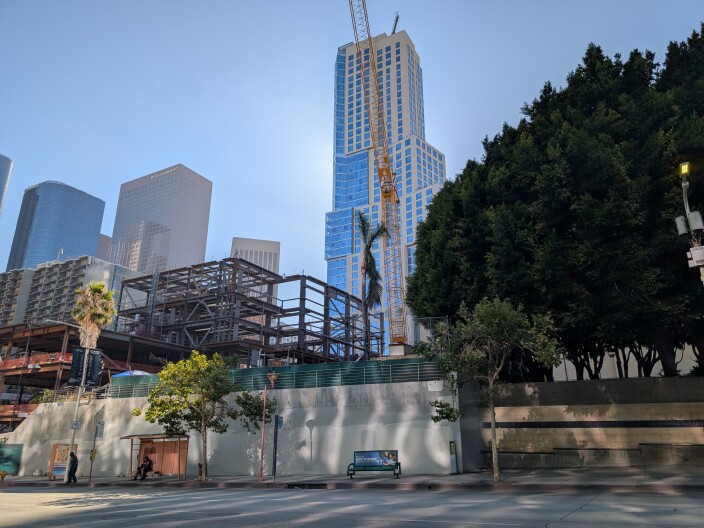A Lone Palm Tree on the Edge of History
Near the corner of First and Hill streets, a lone palm tree stands in a pot, seemingly untouched by time. Known as “Sunshine,” this 50-foot queen palm is more than just a plant—it’s a symbol of resilience, history, and the fading memory of Bunker Hill in downtown Los Angeles.
Kim Cooper, cofounder of Esotouric, a sightseeing company that explores the hidden corners of Los Angeles, describes Sunshine as a “storyteller, a witness, and a survivor.” For Cooper and her husband, Richard Schave, the tree represents more than just a unique botanical specimen; it embodies the spirit of a neighborhood that has seen decades of change.
The story of Sunshine began when a friend noticed the tree standing alone in a patch of dirt at Second and Hill streets. That patch of land, now set to become the site of the expanded Colburn School of Music, was once a part of the original Bunker Hill neighborhood. According to architecture historian Nathan Marsak, the area was a “remnant” of the old hillside, which had been razed in the 1930s to make way for parking lots.
“This was the last bit of untouched earth on old Bunker Hill,” Cooper said. Bunker Hill, once a thriving community of Victorian mansions, transformed over the years into a working-class district, then into a site of forced evictions during the late 1950s. Today, it is home to office towers, cultural institutions, and high-end condos. But amidst all the changes, Sunshine remains—standing tall and proud.
The Significance of a Single Tree
Trees like Sunshine serve as living monuments, anchoring communities to their past and connecting generations. Marsak emphasized that while many queen palms are common in Southern California, the historical significance of this particular tree makes it special. It has survived the destruction of its surroundings, a testament to its strength and endurance.
Donald Hodel, a tree expert who was brought in to assess the palm, noted that while queen palms are widespread, the survival of this one on Bunker Hill adds to its value. “It might be as young as 50 years and as old as 70 years,” Hodel said. Despite not receiving regular care, the tree has developed a deep root system, making it more resilient to neglect.
Hodel also pointed out that the origin of the tree is unclear, but its ability to survive in such conditions suggests it was once well cared for. “The fact that it’s still standing suggests the palm had excellent care for a long time,” he said. This makes the effort to save it even more meaningful.
Efforts to Save Sunshine
Since learning about the Colburn School’s expansion plans, the team behind the campaign to save Sunshine has worked to find a new home for the tree. They have reached out to the school and the construction company, hoping to move the palm to another location within the construction site. While the school has agreed to save the tree, they have not yet decided on a permanent spot.
Potential locations include a small plaza next to Angel’s Flight at Fourth and Hill. The DTLA Alliance, a business coalition, is helping facilitate the relocation, though long-term placement remains uncertain. Schave and Cooper are now turning to Council District 14, hoping that local officials can assist in finding a suitable place for the tree.
“We really believe this could happen,” Schave said. “Sunshine could be moved two blocks down to Fourth and Hill.”
A Legacy Worth Preserving
This isn’t the first time a tree has been moved from Bunker Hill. In 1981, a Moreton Bay fig tree was reportedly relocated to Angelus Plaza. Though the details of the move remain debated, Hodel believes the tree now in the courtyard matches the size and age of the original.
For Schave and Cooper, saving Sunshine is more than just preserving a tree—it’s about honoring the history of Bunker Hill. “You have to save what’s left of old Bunker Hill,” Schave said. “There’s so little left on this hill. So we are not going to lose Sunshine.”






